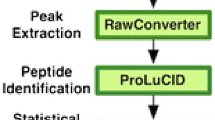Abstract
Bottom-up proteomics is the analysis of peptides derived from single proteins or protein mixtures, and because each protein generates tens of peptides, there is scope for controlled reduction in complexity. We report here a new strategy for selective isolation of the N-terminal peptides of a protein mixture, yielding positionally defined peptides. The method is tolerant of several fragmentation methods, and the databases that must be searched are substantially less complex.


Similar content being viewed by others
References
Bogdanov, B. & Smith, R.D. Mass Spectrom. Rev. 24, 168–200 (2004).
Standing, K.G. Curr. Opin. Struct. Biol. 13, 595–601 (2003).
Steen, H. & Mann, M. Nat. Rev. Mol. Cell Biol. 5, 699–711 (2004).
Smolka, M.B., Zhou, H., Purkayastha, S. & Aebersold, R. Anal. Biochem. 297, 25–31 (2001).
Kasai, K. J. Chromatogr. 597, 3–18 (1992).
Sechi, S. & Chait, B.T. Anal. Chem. 72, 3374–3378 (2000).
Yamaguchi, M. et al. Anal. Chem. 77, 645–651 (2005).
Chelius, D. & Shaler, T.A. Bioconjug. Chem. 14, 205–211 (2003).
Gevaert, K. et al. Nat. Biotechnol. 21, 566–569 (2003).
Martens, L. et al. Proteomics 5, 3193–3204 (2005).
Kuhn, K. et al. J. Proteome Res. 2, 598–609 (2003).
Kuhn, K. et al. Proteomics 5, 2364–2368 (2005).
Doherty, M.K., Whitehead, C., McCormack, H., Gaskell, S.J. & Beynon, R.J. Proteomics 5, 522–533 (2005).
Doherty, M.K. et al. Proteomics 4, 2082–2093 (2004).
Hayter, J.R., Robertson, D.H., Gaskell, S.J. & Beynon, R.J. Mol. Cell. Proteomics 2, 85–95 (2003).
Acknowledgements
Supported by grants to R.J.B. & J.L.H. from the Natural Environment Research Council and the Biotechnology and Biological Sciences Research Council. We are grateful to M. Doherty for assistance with the mass spectrometry.
Author information
Authors and Affiliations
Corresponding author
Ethics declarations
Competing interests
The authors declare no competing financial interests.
Supplementary information
Supplementary Fig. 1
Analysis of N-terminal peptides from mouse skeletal muscle. (PDF 118 kb)
Supplementary Fig. 2
Analysis of N-terminal enriched fraction from mouse liver soluble proteins. (PDF 126 kb)
Supplementary Fig. 3
Theoretical analysis of N-terminal positional peptides from mouse. (PDF 182 kb)
Supplementary Table 1
Identification of proteins in mouse liver from N-terminal peptides. (PDF 163 kb)
Rights and permissions
About this article
Cite this article
McDonald, L., Robertson, D., Hurst, J. et al. Positional proteomics: selective recovery and analysis of N-terminal proteolytic peptides. Nat Methods 2, 955–957 (2005). https://doi.org/10.1038/nmeth811
Received:
Accepted:
Published:
Issue Date:
DOI: https://doi.org/10.1038/nmeth811
- Springer Nature America, Inc.
This article is cited by
-
A novel method for identification and relative quantification of N-terminal peptides using metal-element-chelated tags coupled with mass spectrometry
Science China Chemistry (2014)
-
C-Terminal sequencing of protein by MALDI mass spectrometry through the specific derivatization of the α-carboxyl group with 3-aminopropyltris-(2,4,6-trimethoxyphenyl)phosphonium bromide
Analytical and Bioanalytical Chemistry (2012)
-
Identifying and quantifying proteolytic events and the natural N terminome by terminal amine isotopic labeling of substrates
Nature Protocols (2011)
-
Isotopic labeling of terminal amines in complex samples identifies protein N-termini and protease cleavage products
Nature Biotechnology (2010)
-
Altered proteolytic events in experimental autoimmune encephalomyelitis discovered by iTRAQ shotgun proteomics analysis of spinal cord
Proteome Science (2009)





